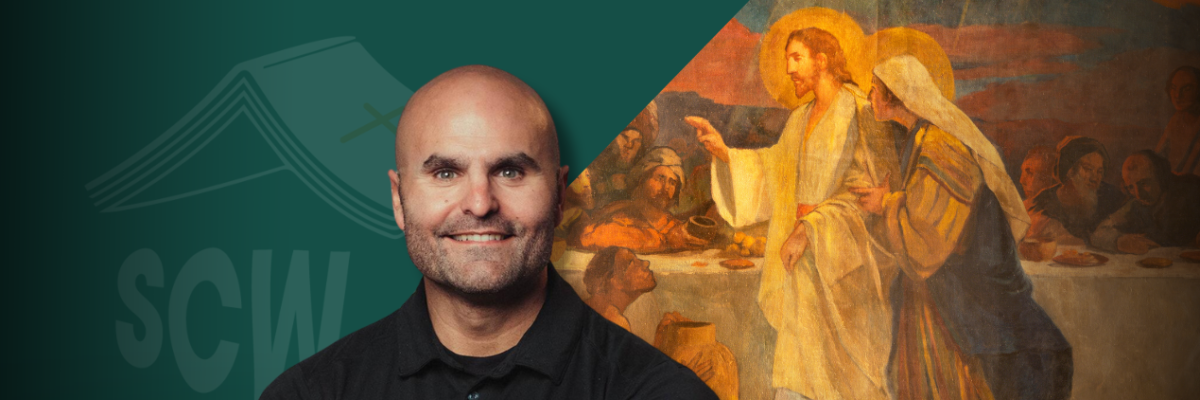
Episode 113: Year C – 2nd Sunday of Ordinary Time
In today’s episode, we focus on one detail found in the Gospel reading, taken from John 2:1-12, which is the Wedding Feast at Cana. The related apologetical topic is Mary’s sinlessness and her role as the New Eve.
Readings: Click Here
Looking for Sunday Catholic Word Merchandise? Look no further! Click Here
Hey everyone,
Welcome to The Sunday Catholic Word, a podcast where we reflect on the upcoming Sunday Mass readings and pick out the details that are relevant for explaining and defending our Catholic faith.
I’m Dr. Karlo Broussard, staff apologist and speaker for Catholic Answers, and the host for this podcast.
In today’s episode, we’re going to focus on one detail found in the Gospel reading, taken from John 2:1-12, which is the Wedding Feast at Cana. The related apologetical topic is Mary’s sinlessness and her role as the New Eve.
Rather than reading the whole Gospel passage, I to begin by focusing solely on Jesus’ response to Mary’s request to help the couple out with the problem of running out of wine: “Woman, how does your concern affect me?”
The first thing to note is that some Protestants appeal to this verse as evidence that Mary wasn’t sinless. “Jesus rebukes Mary here,” so it’s argued, “by calling her woman.” The late Steve Hays makes this argument in his article “Marian Prooftexts” at triablogue.blogspot.
But if we were to follow Hays’ logic here, then we’d have to say that Jesus was rebuking Mary while on the cross because, according to John, he calls Mary “woman” there as well. He says to Mary, “Woman, behold your son” (John 19:26). No one believes Jesus was rebuking Mary here.
So, just because Jesus calls Mary “woman” at the Wedding of Cana doesn’t mean he’s rebuking her. This is simply a case of reading into the text the cultural experience of twenty-first century American.
This, however, just raises the question, “Why does Jesus call Mary ‘woman’?” Well, some scholars have suggested that Jesus is revealing Mary to be the “woman” of Genesis 3:15, the woman whom God separates from the devil, thereby revealing she is not under the devil’s dominion. After Eve’s fall, God says to the serpent, “I will put enmity between you and the woman, and between your seed and her seed; he shall bruise your head, and you shall bruise his heel.”
Now, to see how Mary is revealed to be this woman at the Wedding at Cana we must see it against the backdrop of the creation story that John alludes to in his narrative leading up to the wedding account. Consider, for example, how he begins his Gospel: “in the beginning was the Word.” Obviously, this is an allusion to Genesis 1:1, “in the beginning God created the heavens and the earth.”
John also speaks of the themes of light and darkness in John 1:4-5, explaining that the Word’s “life was the light of men” and it “shines in the darkness.” This alludes to God separating the “light from the darkness” in Genesis 1:4.
John also includes within his narrative the image of the Spirit hovering over water by referencing Jesus’ baptism in John 1:32-33. This conjures up the creation story imagery of the “Spirit of God . . . moving over the face of the waters” in Genesis 1:2.
Finally, John subtly highlights the seventh day theme, which, obviously, is part of the Creation story. The seventh day theme only comes into focus when we consider that John is counting days within his narrative leading up to the wedding at Cana. For example, John begins his narrative in chapter 1 describing how John the Baptist tells the Pharisees that there is one mightier than he and is coming to baptize with the Holy Spirit and fire. John then says in verse 29, “the next day.” On this day, day two of the narrative, John the Baptist encounters Jesus. Then in verse 35, John writes again, “the next day,” which puts us on day three in the narrative where Jesus calls the first disciples. Finally, in verse 43, John writes, “the next day,” putting us on day four of the narrative where Jesus calls the rest of his disciples.
It’s against this backdrop of the four days that John says in John 2:1, “On the third day there was a wedding at Cana.” The first part of the statement, “On the third day,” is left out of the Gospel passage for this upcoming Sunday’s Mass. But, in light of the series of four days prior to this event, this part of the phrase becomes important.
We must ask, “Wait a minute, John. Did you forget to tells us what happened on the third day in the series of days that you’ve counting in your narrative?” Possible! But not probable! Rather, as some scholars point out, the wedding at Cana happens on the third day from the fourth day where he left off, which puts the wedding at Cana happening on the seventh day in the narrative.
It’s against this backdrop of the old creation story that John records the wedding at Cana and Jesus’ exchange with Mary, the implication being that with the wedding at Cana a new creation dawns. And like in the old creation story, in which God foretold about a “woman” and her offspring who would defeat the devil in Genesis 3:15, John records Jesus calling Mary “woman” in this new creation story, the implication being that Mary is the woman of Genesis 3:15 and Jesus is her offspring, and this miracle at the wedding at Cana begins the crushing of the serpent’s head.
Now, as the woman of Genesis 3:15, we can infer that Mary is sinless, both with regard to original and personal sin. How so?
Well, God says to the serpent, “I will set enmity between you and the woman, between your seed and her seed; he shall bruise your head, and you shall bruise his heel.”
Consider that on a spiritual and prophetical level Christians throughout the centuries have viewed this text as the protoevangelium, seeing in the “seed of the woman” a prophetical reference to Jesus. On this prophetical view, the “enmity” that the woman’s seed has with Satan (“I will put enmity between . . . your seed and her seed”) is complete and perfect, involving no sin whatsoever, whether original or personal, given that Christians believe Jesus was free from both original and personal sin (Heb. 4:15).
Now, according to the inspired author, the enmity that Jesus has with Satan is equally applied to the woman: “I will put enmity between you and the woman, and between your seed and her seed.” Since on this prophetical level of interpretation the enmity between Satan and Jesus is complete, which means freedom from both original and personal sin, it follows that on the prophetical view the enmity between Satan and the woman is also complete—the prophetical woman, Mary, is to be free from both original and personal sin.
Moreover, there seems to be a contrast between the new woman and the first woman, Eve, in the spiritual sense of the text. If the enmity between the new woman and Satan were not to be complete and permanent, as a Protestant might argue, then there would be nothing new about the prophetical woman. She would be just like Eve in that she would eventually fall under Satan’s dominion due to sin. Such an interpretation would undermine the biblical typology that God is intending to establish in the spiritual sense of the text.
Now, Protestant apologist Ron Rhodes thinks it’s a stretch to apply “the woman” to Mary. But he’s willing to concede this for argument’s sake. Even on this reading, Rhodes doesn’t see the text as suggestive of Mary’s sinlessness. In his book Reasoning from the Scriptures with Catholics (pg. 292-293), he writes,
For, indeed, the text indicates that while there will be enmity between the offspring of the woman and that of the devil, nevertheless the victory itself lies in the Messiah alone, who is one individual from among the woman’s seed. It is never prophesied that “the woman” herself would be victorious, so any need for an immaculate conception of the woman vanishes. The woman’s only significant role is to give birth to the human-divine Messiah.
This argument is based on the premise that if this passage is to converge with the Catholic Tradition that Mary was without sin, it would have to speak of the woman having victory over the serpent like the Messiah. But that’s not true. Given our above argument that on the prophetical level the enmity between Satan and the woman is complete, the enmity that God puts between Satan and the woman is sufficient to affirm a convergence.
Moreover, even though the Hebrew text for this passage does indicate that the seed of the woman will crush the head of the serpent, it’s also legitimate to see in the text the woman crushing the serpent’s head, at least in an indirect way. The reason is that the woman, Mary, cooperated in the events that led to the serpent’s head being crushed. She agreed to be the vessel for the male child to come into the world for the sake of crushing the serpent’s head (Luke 1:38). She was struck by the serpent insofar as she suffered seeing her son hanging on the cross, which was prophesied by Simeon: “a sword will pierce through your own soul also” (Luke 2:35). Jimmy Akin sums it up nicely in his Catholic Answers article “Who Will Crush the Serpent’s Head?”. He writes,
Jesus directly crushed the serpent and was directly struck by the serpent, while Mary indirectly crushed it and was indirectly struck by it, due to her cooperation in becoming the mother of Christ.
Given that Catholics have grounds to read in a spiritual way the woman crushing the serpent’s head, Catholics could meet the above challenge and say, “The woman does have victory over the devil.” And if victory over the devil is required to see a reference to the woman’s sinlessness, and we can see the woman as a prophetical image of Mary, then Catholics can read the woman’s victory as a reference to Mary’s sinlessness.
Note that everything I shared here is in written form in my book Meeting the Protestant Response: How to Answer Common Comebacks to Catholic Arguments.
Conclusion
Well, my friends, that does it for this episode of the Sunday Catholic Word. The Gospel reading for this upcoming 2nd Sunday of Ordinary Time, year C, which is the wedding at Cana, provides us with material for Marian apologetics. She is revealed to be the woman of the new Creation, the New Eve, and thereby sinless, upon her creation and throughout her life.
As always, I want to thank you for subscribing to the podcast. And please be sure to tell your friends about it and invite them to subscribe as well through any podcast platform that they use. You can also access the archived episodes of the Sunday Catholic Word at sundaycatholicword.com.
You might also want to check out the other great podcasts in our Catholic Answers podcast network: Cy Kellet’s Catholic Answers Focus, Trent Horn’s The Counsel of Trent, Joe Heschmeyer’s Shameless Popery, Jimmy Akin’s The Jimmy Akin podcast, and Tim Staples “1 on 1 with Tim,” all of which can be found at catholic.com.
One last thing: if you’re interested in getting some cool mugs and stickers with my logo, “Mr. Sunday podcast,” go to shop.catholic.com.
I hope you have a blessed 2nd Sunday of Ordinary Time, Year C. Until next time, God Bless.



